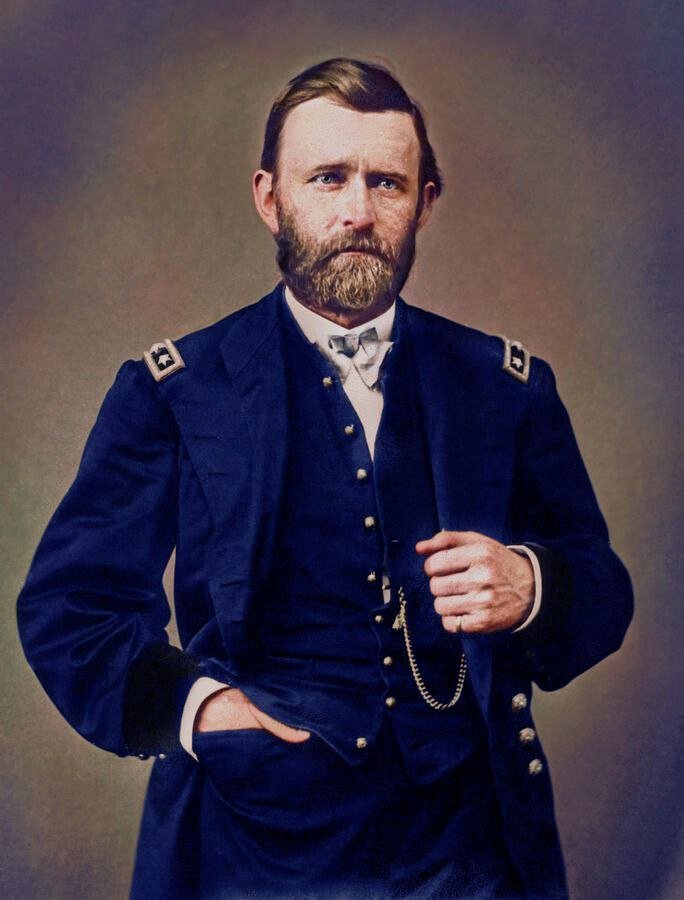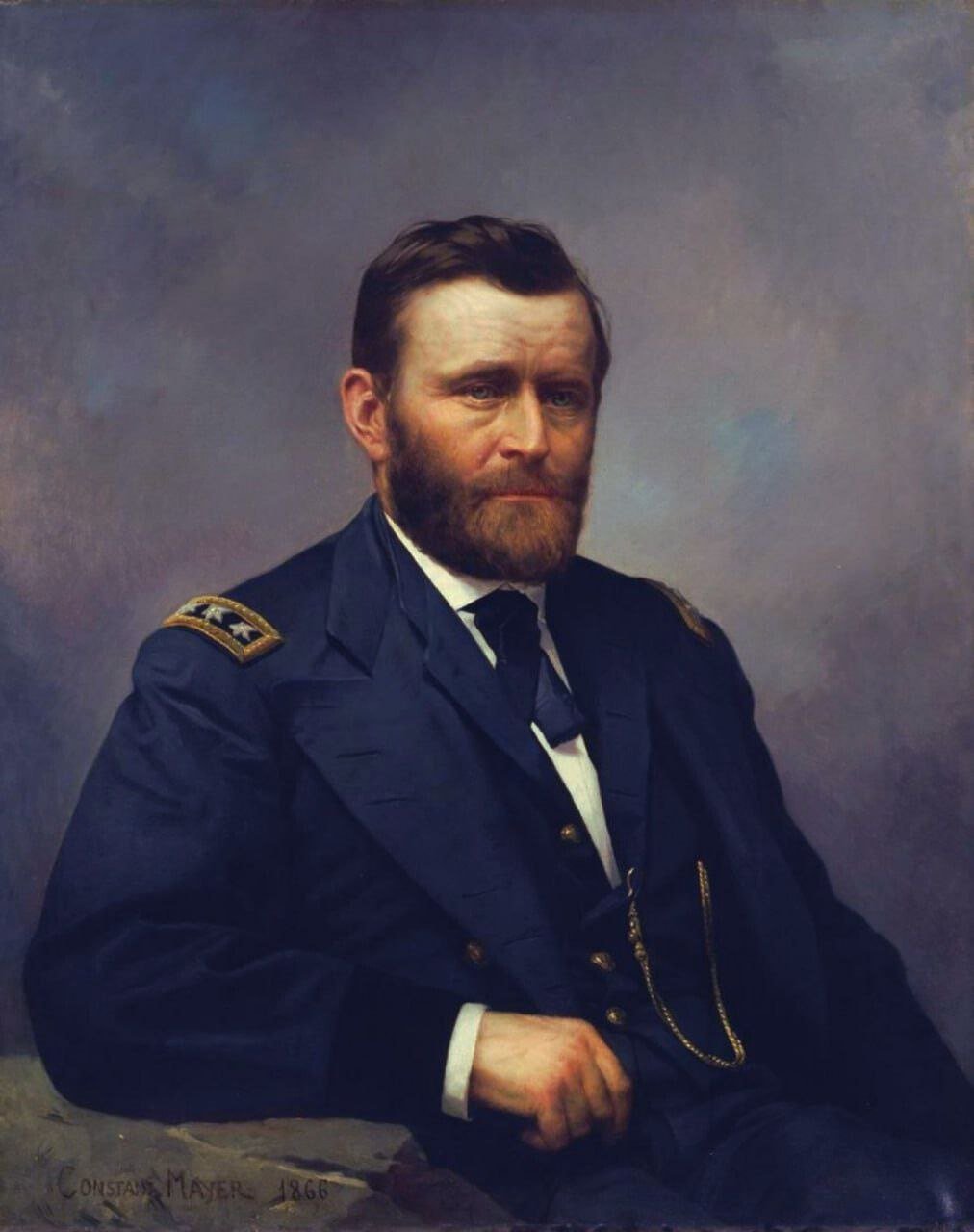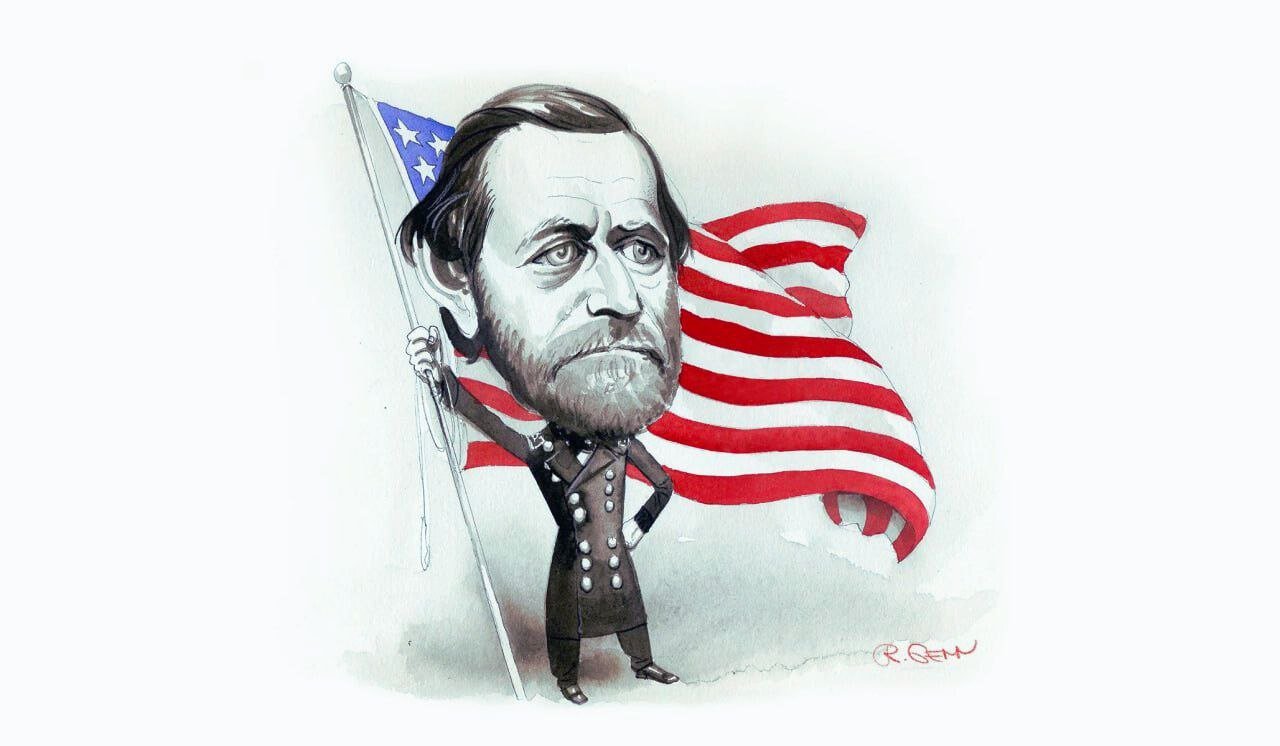
Contents
- Early Life and Military Career of Ulysses S. Grant
- The Outbreak of the Civil War and Grant’s Rise to Prominence
- Grant’s Leadership in Major Battles
- Grant’s Appointment as General-in-Chief
- The Overland Campaign and the Siege of Petersburg
- The Final Campaigns and the Surrender at Appomattox
- Grant’s Post-War Legacy and Presidency

The American Civil War, spanning from 1861 to 1865, stands as one of the most pivotal conflicts in United States history. The war erupted primarily over deep-seated issues such as states’ rights and slavery, catalyzing a national crisis that would ultimately shape the nation’s future. The war pitted the Northern states, collectively known as the Union, against the Southern states, which had seceded to form the Confederacy. Both sides were driven by contrasting ideologies, economic interests, and political objectives, leading to a prolonged and bloody struggle.
The war began on April 12, 1861, with the Confederate attack on Fort Sumter in South Carolina, signaling the start of hostilities. Over the next four years, numerous battles would unfold across various theaters of war, involving significant figures such as President Abraham Lincoln and Confederate President Jefferson Davis. Central to the conflict was Ulysses S. Grant, a Union general whose military acumen would play a crucial role in leading the North to victory.

Beyond the battlefield, the American Civil War had profound social, economic, and political implications. It marked the end of slavery in the United States, a legacy cemented by the Emancipation Proclamation and the 13th Amendment. The war also ushered in a new era of federal authority over the states, fundamentally altering the balance of power within the American political system. The Reconstruction era that followed sought to address the deep wounds left by the conflict, though it would face numerous challenges and setbacks.
The significance of the American Civil War extends far beyond its immediate outcomes. It stands as a testament to the nation’s capacity for self-examination and change, setting a precedent for future civil rights movements. The war’s legacy continues to resonate in contemporary discussions about race, equality, and federalism, highlighting its enduring impact on American society. As we delve deeper into the documentary featuring Ulysses S. Grant, we gain not only a better understanding of the war itself but also of the broader narrative of American history.
Early Life and Military Career of Ulysses S. Grant
Ulysses S. Grant, born on April 27, 1822, in Point Pleasant, Ohio, would grow to become one of the most significant figures in American military history. Grant’s early life was marked by a blend of modesty and potential. His father, Jesse Root Grant, was a tanner and a businessman, while his mother, Hannah Simpson Grant, managed the household. The young Grant exhibited a talent for horsemanship, a skill that would later serve him well in his military career.

In 1839, Ulysses S. Grant entered the United States Military Academy at West Point, New York. Despite his initial reluctance and struggles with certain academic subjects, he graduated in 1843, ranking 21st in a class of 39. Grant’s time at West Point laid the foundation for his military discipline and strategic thinking, qualities that would be invaluable in his later years.
Upon graduation, Grant was assigned to the 4th U.S. Infantry and stationed at various posts. His first significant military experience came during the Mexican-American War (1846-1848), where he served under future Civil War generals like Zachary Taylor and Winfield Scott. Grant distinguished himself in battles such as Palo Alto and Resaca de la Palma, earning a reputation for bravery and tactical acumen.
Despite his military successes, Grant faced substantial challenges in his civilian life following the Mexican-American War. Resigning from the army in 1854, he struggled with various business ventures and was often plagued by financial difficulties. His attempts at farming, real estate, and other endeavors met with limited success, leading to a period of personal and professional uncertainty.
However, the outbreak of the Civil War in 1861 marked a turning point for Grant. His military expertise and leadership qualities were soon recognized, propelling him back into service. From this moment, Grant’s career would ascend rapidly, culminating in his crucial role in leading the Union Army to victory.

The Outbreak of the Civil War and Grant’s Rise to Prominence
The American Civil War, a pivotal chapter in United States history, erupted in April 1861 following years of tension between the Northern and Southern states over issues such as slavery and states’ rights. The secession of Southern states and the formation of the Confederate States of America marked the beginning of armed conflict. Amid this national turmoil, Ulysses S. Grant emerged as a significant military figure.
Grant, who had resigned from the army in 1854, rejoined the military at the outbreak of the Civil War, driven by a sense of duty and patriotism. Initially, he was appointed to command a volunteer regiment. His leadership skills and military acumen quickly became apparent, leading to his promotion to brigadier general in August 1861. Grant’s strategic prowess was first demonstrated during the capture of Fort Donelson in February 1862, a key victory for the Union.
Fort Donelson was a Confederate stronghold on the Cumberland River in Tennessee. Its capture was crucial for the Union’s efforts to gain control of strategic waterways and hinder Confederate supply lines. Grant orchestrated a bold and effective assault on the fort, culminating in the Confederate garrison’s surrender. His demand for “unconditional and immediate surrender” became legendary, earning him the nickname “Unconditional Surrender” Grant. This victory not only boosted Union morale but also marked Grant’s ascent within the military hierarchy.
Following the success at Fort Donelson, Grant’s reputation as a competent and decisive leader solidified. He continued to demonstrate his military prowess in subsequent engagements, such as the Battle of Shiloh. His ability to secure significant victories and manage complex operations led to his rapid rise through the ranks, eventually positioning him as one of the Union’s most prominent generals.
Thus, the early stages of the Civil War saw Ulysses S. Grant rise from relative obscurity to national prominence, thanks to his strategic brilliance and leadership during critical battles. His contributions during this period were instrumental in shaping the course of the war and setting the stage for future Union successes.
Grant’s Leadership in Major Battles
Ulysses S. Grant’s leadership during pivotal battles of the American Civil War showcased his strategic acumen and unyielding resolve, significantly impacting the Union’s success. One of the earliest major engagements where Grant’s command prowess was evident was the Battle of Shiloh in April 1862. Though initially caught off guard by Confederate forces, Grant’s ability to organize a staunch defense and plan a counterattack ultimately led to a critical Union victory. His insistence on holding ground despite heavy losses demonstrated his determination and commitment to long-term objectives.
The Vicksburg Campaign further highlighted Grant’s strategic genius. By May 1863, Grant had effectively maneuvered his forces around the strategic city of Vicksburg, Mississippi, executing a series of complex movements that culminated in the Siege of Vicksburg. His strategy of cutting off the city and laying siege until the Confederate forces surrendered was a masterstroke that severed the Confederacy’s control over the Mississippi River. This victory not only split the Confederacy geographically but also bolstered Northern morale and solidified Grant’s reputation as a formidable military leader.
Grant’s contributions were equally significant in the Battle of Chattanooga in November 1863. Facing a critical situation where Union forces were besieged, Grant devised a comprehensive strategy to break the siege and drive Confederate troops from their strongholds. His coordination of multiple assaults, including the famous charge up Missionary Ridge, showcased his ability to inspire and direct troops effectively under pressure. The successful outcome of this battle opened the gateway to the Deep South, paving the way for Sherman’s Atlanta Campaign and subsequent March to the Sea.
Through these major battles, Grant’s leadership was characterized by his unwavering focus on strategic objectives, adaptive tactics, and a relentless pursuit of victory. His ability to navigate complex battlefield dynamics and make decisive, often bold, moves were instrumental in turning the tide of the war in favor of the Union, ultimately leading to its triumph.
Grant’s Appointment as General-in-Chief
Ulysses S. Grant’s remarkable military successes throughout the Civil War ultimately led to his appointment as General-in-Chief of the Union armies by President Abraham Lincoln in March 1864. Grant had demonstrated exceptional leadership and strategic acumen during key campaigns such as the Vicksburg Campaign and the Battle of Chattanooga. His ability to secure crucial victories and maintain the morale of his troops did not go unnoticed, earning him the trust and confidence of Lincoln and other Union leaders.
Upon his appointment, Grant was faced with a multitude of challenges. The Union army was vast and dispersed across various theaters of war, each presenting unique difficulties. Additionally, Grant inherited a military structure riddled with political complexities, internal conflicts, and logistical hurdles. His overarching strategy, however, was clear and resolute: to apply relentless pressure on Confederate forces simultaneously across multiple fronts, thereby preventing them from regrouping and reinforcing.
Grant’s strategic vision involved coordinating the efforts of several major Union armies. He directed General William Tecumseh Sherman to advance through the South, targeting key infrastructure and supply lines, while he personally led the Overland Campaign against General Robert E. Lee’s Army of Northern Virginia. This multi-pronged approach aimed to exhaust the Confederacy’s resources and diminish their capacity to wage war.
One of Grant’s notable attributes was his determination and willingness to engage in continuous, aggressive warfare. Unlike some of his predecessors, who were often cautious and hesitant, Grant believed in maintaining constant pressure on the enemy. This relentless pursuit ultimately forced the Confederates into a war of attrition, which they were ill-equipped to sustain.
Grant’s tenure as General-in-Chief was marked by his ability to inspire and mobilize large numbers of troops, his strategic ingenuity, and his unwavering commitment to the Union cause. His leadership played a pivotal role in shifting the momentum of the war in favor of the Union, setting the stage for its eventual victory.
The Overland Campaign and the Siege of Petersburg
The Overland Campaign, launched in May 1864, was a pivotal series of battles orchestrated by General Ulysses S. Grant with the objective of wearing down Confederate forces and capturing the Confederate capital of Richmond. This series of engagements marked a shift in Union strategy, focusing on continuous and aggressive confrontation.
The campaign commenced with the Battle of the Wilderness, fought from May 5 to May 7, 1864, in dense forested terrain in Virginia. The battle was characterized by brutal close-quarters combat and high casualties. Despite the lack of a decisive victory, Grant’s refusal to retreat, unlike his predecessors, demonstrated his resolve to relentlessly pursue Confederate General Robert E. Lee’s army.
Following the Wilderness, Grant moved his forces southeast to Spotsylvania Court House. The ensuing battle, from May 8 to May 21, 1864, was marked by fierce fighting, particularly at the infamous “Bloody Angle,” a section of the Confederate defensive line. Although the Union forces were unable to break through, they inflicted significant losses on Lee’s army, further depleting its strength.
Undeterred, Grant continued his offensive towards Cold Harbor, where one of the most devastating assaults of the campaign occurred from May 31 to June 12, 1864. The Union troops suffered heavy casualties in frontal assaults against well-entrenched Confederate positions. The high cost of this battle underscored the relentless and attritional nature of Grant’s strategy.
The Overland Campaign culminated in the Siege of Petersburg, which began in June 1864 and lasted until April 1865. Petersburg was a vital railroad hub, supplying Richmond and the Confederate armies. Recognizing its strategic importance, Grant laid siege to the city, employing trench warfare tactics that foreshadowed World War I. The prolonged siege gradually choked off supplies to the Confederate capital, weakening Lee’s forces and contributing to the eventual fall of Richmond.
Grant’s Overland Campaign and the Siege of Petersburg were crucial in depleting Confederate resources and morale. These operations showcased his strategic acumen and relentless determination, playing a significant role in the eventual Union victory in the American Civil War.
The Final Campaigns and the Surrender at Appomattox
As the American Civil War drew to a close, commanding General Ulysses S. Grant orchestrated a series of decisive campaigns that would culminate in the fall of Richmond and ultimately lead to the surrender of General Robert E. Lee’s Confederate forces. These final operations were characterized by relentless pressure and strategic maneuvering, aimed at depleting the already dwindling resources of the Confederate army.
The Overland Campaign, which began in May 1864, marked the beginning of Grant’s aggressive push towards the Confederate capital. This campaign was notable for its brutal nature and high casualties, exemplified by the battles of the Wilderness, Spotsylvania Courthouse, and Cold Harbor. Despite the heavy losses, Grant’s strategy of attrition steadily wore down Lee’s forces, forcing them into a defensive posture.
In the latter part of 1864, Grant shifted his focus to Petersburg, a vital supply center for Richmond. The Siege of Petersburg, lasting from June 1864 to April 1865, saw Union forces cutting off supply lines and conducting a series of offensives that eventually weakened the Confederate defenses. The fall of Petersburg on April 2, 1865, directly led to the abandonment of Richmond by Confederate forces, signaling the imminent collapse of the Confederacy.
Following the fall of Richmond, Grant pursued Lee’s retreating army westward. The Union forces, vastly superior in numbers and resources, systematically closed in on the dwindling Confederate troops. This pursuit culminated in the Battle of Appomattox Court House on April 9, 1865. Facing insurmountable odds and recognizing the futility of continued resistance, General Lee met with General Grant to negotiate terms of surrender.
The surrender at Appomattox Court House effectively marked the end of the Civil War. Grant’s magnanimous terms allowed Confederate soldiers to return home with their personal possessions and horses, fostering a spirit of reconciliation and paving the way for the nation’s arduous process of reconstruction.
Grant’s Post-War Legacy and Presidency
Following his instrumental role in the American Civil War, Ulysses S. Grant transitioned from a celebrated military leader to a significant political figure. His two-term presidency, spanning from 1869 to 1877, was marked by efforts to stabilize a nation still reeling from the aftermath of the Civil War and to advance civil rights for formerly enslaved individuals.
Grant’s presidency began with a strong focus on Reconstruction, a critical period aimed at reintegrating the Southern states and ensuring civil rights for African Americans. One of his notable achievements was the enforcement of the 15th Amendment, which granted African American men the right to vote. His administration worked tirelessly to suppress the violent actions of groups like the Ku Klux Klan, employing federal troops to protect African American citizens and maintain order in the South.
Beyond civil rights, Grant’s presidency also tackled significant economic and infrastructural developments. He advocated for the establishment of the Department of Justice, which played a pivotal role in enforcing federal laws. His administration also saw the completion of the Transcontinental Railroad, a monumental project that significantly boosted the nation’s economic growth and facilitated westward expansion. However, his tenure was not without challenges. The Grant administration was plagued by several scandals, including the infamous Whiskey Ring, which tarnished his reputation despite his personal integrity remaining largely unscathed.
Grant’s post-presidential years were marked by a world tour, where he was warmly received as a global statesman. His reflections on his time in office and the Civil War were later compiled into his memoirs, which are considered some of the most significant military writings of the 19th century. His leadership during the Civil War and his efforts in Reconstruction had a lasting impact on American history, shaping the nation’s trajectory toward a more unified and equitable society.
Grant’s legacy, both as a formidable military leader and a dedicated public servant, continues to be a subject of study and admiration. His commitment to civil rights and his role in the Reconstruction era underscore his enduring influence on the fabric of American history.
OUR SITE: toinewsalert.com







